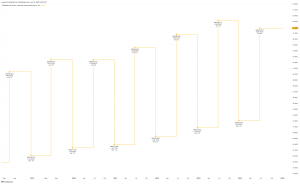I’m hoping to have some cash to invest in my Stocks and Shares ISA next month. So I’m building a list of exchange-traded funds (ETFs) I think might help supercharge my returns.
By holding a basket of assets, ETFs carry lower risk than investing in individual securities. These diversified instruments can also be highly cost-effective, with lower expense ratios and fewer fees compared to mutual funds. And like stocks, they can be bought and sold throughout the trading day.
Here’s one I think’s worth serious consideration next month.
Gold bulls in charge
Gold prices are heading through the roof. They’ve just touched new record peaks above $2,500 per ounce, and may have much further to run as central banks cut rates, the US dollar weakens, and conflicts threaten to widen in Eastern Europe and the Middle East.
Recent data underlines how sharply demand for gold-backed assets is accelerating. According to the World Gold Council (WGC), global gold ETFs enjoyed their strongest month since April 2022 in July, attracting $3.7bn of inflows.
Meanwhile, bullion demand among central banks is also still hotting up. Banks purchased more than 1,000 tonnes in both 2022 and 2023, and according to a WGC survey, almost 30% plan to keep building their holdings.
Against this backcloth, analysts at Citi think the expensive metal will rise as high as $3,000 over the next year or so. This may not be a surprise to you. Gold’s already almost doubled in value since August 2014.
A top ETF
In this climate, I think opening a position in the Van Eck Gold Miners UCITS ETF (LSE:GDGB) could be a great idea for me in September. The fund — which tracks the NYSE Arca Gold Miners Index — has one of the lowest expense ratios of its type, at just 0.53%.
If the gold price continues to rise, the ETF will likely follow suit as mining sector profits boom. In fact, it could provide superior returns if the companies it holds put in strong operational performances.
The opposite might also happen if miners experience trouble such as disappointing payloads or increased costs. However, around 65% of the total fund’s allocated to established miners with stable cash flows, which helps soothe any concerns I’d otherwise have.
We’re talking about industry giants such as Newmont Mining, Wheaton Precious Metals, and Barrick Gold.
Dividend drawback
One thing to remember is that the fund doesn’t pay out a dividend. Instead, any income it generates would be automatically reinvested back into the ETF.
This may put some investors off. But it wouldn’t be enough to discourage me from buying. As a way of balancing risk and reward, I still think it could be a better way to get gold exposure than by buying shares in one or two dividend-paying miners.
If I have cash to invest soon, I’ll be looking to add the fund to my own ISA.
This post was originally published on Motley Fool







